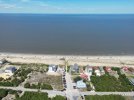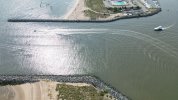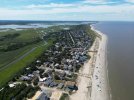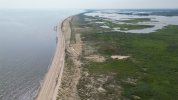I have footage of that building with the solar panels, that I didn't put on YouTube, and it's not flat. Maybe 20% angle or more. I didn't know where that building was, or if I would have access to it. I also had never used find my drone. Yes, if my drone had been run over by a vehicle, I would of wished I had landed there.That's not what the video shows. In this still frame, the solar panels are parallel with the flat roof surface. Do you have access to that roof to know differently? If so, why didn't you just land it on the gray roof section behind the solar panels, and retrieve the drone at your convenience?
View attachment 158350
You are using an out of date browser. It may not display this or other websites correctly.
You should upgrade or use an alternative browser.
You should upgrade or use an alternative browser.
That set of solar panels would have been a perfect ditch landing spot. Nice and flat, even if slightly tipped. Being up on a rooftop, it's also isolated and remote, giving you the chance to get to it before someone else does! You also would not have lost signal until it landed, and even a critical battery landing from just above there would have been safe. You could also have reset the HP to the drone location when over that spot, and then easily located it on the map afterwards, even without Find My Drone.I have footage of that building with the solar panels, that I didn't put on YouTube, and it's not flat. Maybe 20% angle or more. I didn't know where that building was, or if I would have access to it. I also had never used find my drone. Yes, if my drone had been run over by a vehicle, I would of wished I had landed there.
BroomRider
Well-Known Member
My grandfather had a saying he gave me when I was a youngster in my single digits, learning to row a boat on the DE river, “Never travel farther from the shore than you are able to swim.”
Full sized (military?) aircraft pilots have an Alpha-Bingo fuel flight time rule when flying over water (for instance). Alpha is the fuel (i.e., the time you have to remain in the air) that you carry at the start of the flight, & Bingo is 2/3 the level, & dictates the point when a return is required. The remaining amount is there to help account for unforeseen difficulties (i.e., headwinds) that might be encountered on the way back.
Early in my flights with my new M3P, I wanted to see how far it would fly, & I got a pretty good indication, & a lesson too (every flight is a “schooling”, for me at least).
The wind was mild & coming onshore (
 ), & I flew from Broadkill Beach to Roosevelt Inlet (this is in Sussex County, Delaware). I had to gradually increase the altitude to maintain the signal strength, on up to the maximum of 400' along the latter portion of the distance. I hovered a wee bit to choose a good pic, took it, & about then, the battery level RTH kicked in, which was a good thing as the signal strength was also pretty low. I wasn't going to argue with it!
), & I flew from Broadkill Beach to Roosevelt Inlet (this is in Sussex County, Delaware). I had to gradually increase the altitude to maintain the signal strength, on up to the maximum of 400' along the latter portion of the distance. I hovered a wee bit to choose a good pic, took it, & about then, the battery level RTH kicked in, which was a good thing as the signal strength was also pretty low. I wasn't going to argue with it!
What I learned was, it wouldn't take me back along the route I took on the way there, which was along & over the open beach & thus, in a long & gradual curved route, where I could have taken a (long!) walk to go fetch it in case something bad happened.
Instead, it took me back in a direct line, which took me out over the open (Salt!) water. White knuckles time! I'd never flown that far before & neither had I flown over water before. But, since I didn't deny the RTH & the wind was coming onshore at a ~90 degree angle to the flight path, I made it back safely. I didn't want to mess with anything on the way back, me being a noob at flying a drone, & being over (Salt!) water.
If I had canceled the RTH, likely I would have turned the drone into a submarine on a 1-way trip to the bottom.
If I recall correctly, the 1-way distance was somewhere ~>5 miles. You can look up the locations on the interweb & check for yourself.
A similar test was done in the opposite direction, similar M.O. & this again from the same starting point, towards Fowler Beach, as I recall, somewhere ~>6 miles 1-way.
At no time was I flying over anyone or anything that, if something bad happened, I couldn't have chosen a safe landing spot on the way down. (Not that salt water is safe, but it's better that than hurt someone or damage property!)
The photos below are, in order, my starting point (looking ~NE), en route ~SE, the inlet (looking ~SE), 2nd en route (looking ~NW) & ~Fowler Beach (looking ~SE).
I think that I picked a good location, & weather.
Full sized (military?) aircraft pilots have an Alpha-Bingo fuel flight time rule when flying over water (for instance). Alpha is the fuel (i.e., the time you have to remain in the air) that you carry at the start of the flight, & Bingo is 2/3 the level, & dictates the point when a return is required. The remaining amount is there to help account for unforeseen difficulties (i.e., headwinds) that might be encountered on the way back.
Early in my flights with my new M3P, I wanted to see how far it would fly, & I got a pretty good indication, & a lesson too (every flight is a “schooling”, for me at least).
The wind was mild & coming onshore (
 ), & I flew from Broadkill Beach to Roosevelt Inlet (this is in Sussex County, Delaware). I had to gradually increase the altitude to maintain the signal strength, on up to the maximum of 400' along the latter portion of the distance. I hovered a wee bit to choose a good pic, took it, & about then, the battery level RTH kicked in, which was a good thing as the signal strength was also pretty low. I wasn't going to argue with it!
), & I flew from Broadkill Beach to Roosevelt Inlet (this is in Sussex County, Delaware). I had to gradually increase the altitude to maintain the signal strength, on up to the maximum of 400' along the latter portion of the distance. I hovered a wee bit to choose a good pic, took it, & about then, the battery level RTH kicked in, which was a good thing as the signal strength was also pretty low. I wasn't going to argue with it!What I learned was, it wouldn't take me back along the route I took on the way there, which was along & over the open beach & thus, in a long & gradual curved route, where I could have taken a (long!) walk to go fetch it in case something bad happened.
Instead, it took me back in a direct line, which took me out over the open (Salt!) water. White knuckles time! I'd never flown that far before & neither had I flown over water before. But, since I didn't deny the RTH & the wind was coming onshore at a ~90 degree angle to the flight path, I made it back safely. I didn't want to mess with anything on the way back, me being a noob at flying a drone, & being over (Salt!) water.
If I had canceled the RTH, likely I would have turned the drone into a submarine on a 1-way trip to the bottom.
If I recall correctly, the 1-way distance was somewhere ~>5 miles. You can look up the locations on the interweb & check for yourself.
A similar test was done in the opposite direction, similar M.O. & this again from the same starting point, towards Fowler Beach, as I recall, somewhere ~>6 miles 1-way.
At no time was I flying over anyone or anything that, if something bad happened, I couldn't have chosen a safe landing spot on the way down. (Not that salt water is safe, but it's better that than hurt someone or damage property!)
The photos below are, in order, my starting point (looking ~NE), en route ~SE, the inlet (looking ~SE), 2nd en route (looking ~NW) & ~Fowler Beach (looking ~SE).
I think that I picked a good location, & weather.
Attachments
If I had canceled the RTH, likely I would have turned the drone into a submarine on a 1-way trip to the bottom.
Not true. Canceling low battery RTH would have allowed you to safely return along the same route you had flown, over dry land, where you could have landed anywhere along the way, had that been necessary. Low battery RTH is very conservative, and wants to land with 30% battery! It is always best to cancel it and take over manual flight. Even "loss of signal" RTH should be cancelled as soon as signal is restored, so you are fully in control, and can lower the altitude to stay under any wind and fly at a faster, more optimal speed for distance than the slow RTH speed, and even kick it into Sport, if needed, to overcome a brutal headwind. Lessons learned!
BroomRider
Well-Known Member
Verily, Verily, & Forsooth!Not true. Canceling low battery RTH would have allowed you to safely return along the same route you had flown, over dry land, where you could have landed anywhere along the way, had that been necessary. Low battery RTH is very conservative, and wants to land with 30% battery! It is always best to cancel it and take over manual flight. Even "loss of signal" RTH should be cancelled as soon as signal is restored, so you are fully in control, and can lower the altitude to stay under any wind and fly at a faster, more optimal speed for distance than the slow RTH speed, and even kick it into Sport, if needed, to overcome a brutal headwind. Lessons learned!
Now that I've gotten many miles & hours of flying the M3P under my belt, that's what I would have done.
However, what I described above was very early in my drone flying & self-teaching. I've watched many How-To videos since then, & continue to do so, along with picking up valuable information from more experienced persons such as yourself in forums such as this.
As they say, hindsight is always 20-20.
When I mentioned cancelling the RTH, I meant, ignoring it to hang out a bit longer at the far end of my flights; again, me being (still a relative?) noob, had no idea exactly how much leeway I had with the battery life & time left in the air.
Since I had just gotten it for myself as a B-Day gift to me, I didn't want to risk losing it, & I have a habit of when being in doubt, playing conservatively.
Yes, that's the main reason I cancel low battery RTH, to continue on. However, I know from experience exactly what I can get away with, and that experience comes with over 3,000 flights and 1,000 hours of drone flying, with hard learned mistakes along the way! I am constantly recalculating, based upon distance from home, and minutes per mile needed to make it back at max Normal speed, with a margin for error for any headwind, or a 360 Pano along the way, when close enough that I know I can still safely squeeze it in! Baby steps until you get there.When I mentioned cancelling the RTH, I meant, ignoring it to hang out a bit longer at the far end of my flights; again, me being (still a relative?) noob, had no idea exactly how much leeway I had with the battery life & time left in the air.
Last edited:
veryzebra
Well-Known Member
OP, sounds like you're annoyed and want to change settings etc. My suggestion is put the drone down for a few days. Then consider possibly you just made a mistake in judgement. It happens and we learn from them. The settings are what they are for our safety and the safety of others first. Some of the advice in here like fly it as high as you can when that happens, sounds dangerous and the opposite of what you should do. Read as much as you can about RTH and low battery levels. Don't fly until such low battery or if you do, then do it in an open location close to you so you can understand exactly what will happen. It's always temping to get just a few more seconds or finish this shot etc. You could land, swap batteries and finish then edit them together etc. Remember in the end, we're just taking photos or making videos. Not worth jeopardizing someone's safety.
That's my take at least and some may disagree. Hope you enjoy the drone, get a lot of use out of it and stick around.
That's my take at least and some may disagree. Hope you enjoy the drone, get a lot of use out of it and stick around.
Similar threads
- Replies
- 96
- Views
- 4K
- Replies
- 10
- Views
- 1K
- Replies
- 13
- Views
- 854
DJI Drone Deals
New Threads
-
-
US exempts some foreign-made drones from FCC import ban on new models
- Started by Occams Razor
- Replies: 2
-
-
5P has that crazy Air 3S RTH under trees, through buildings
- Started by Droning on and on...
- Replies: 1
-
Members online
Total: 2,025 (members: 9, guests: 2,016)














